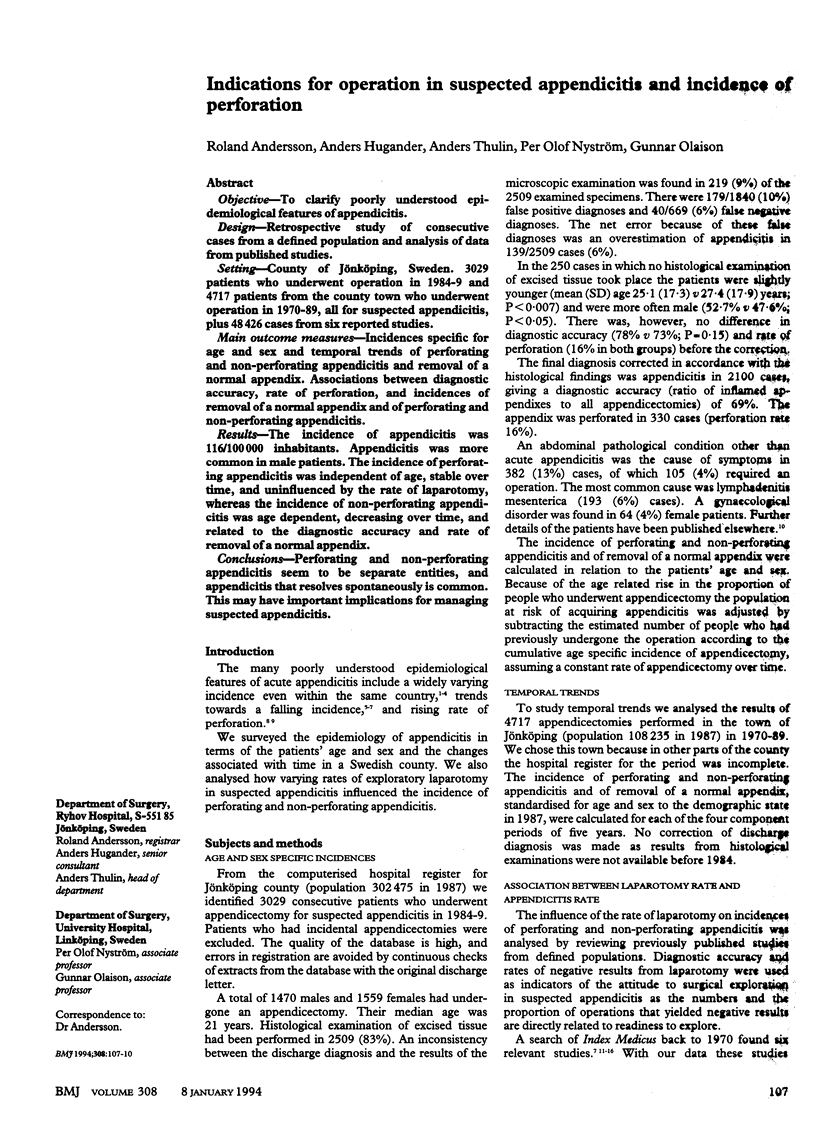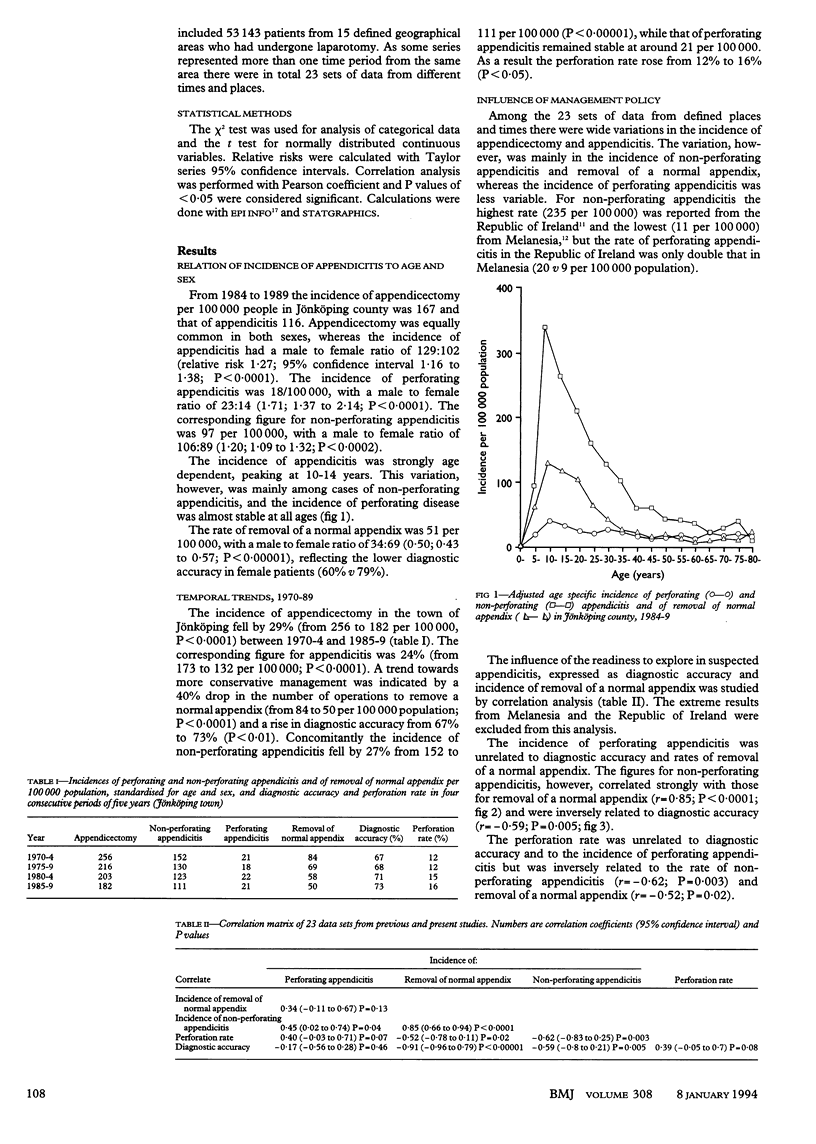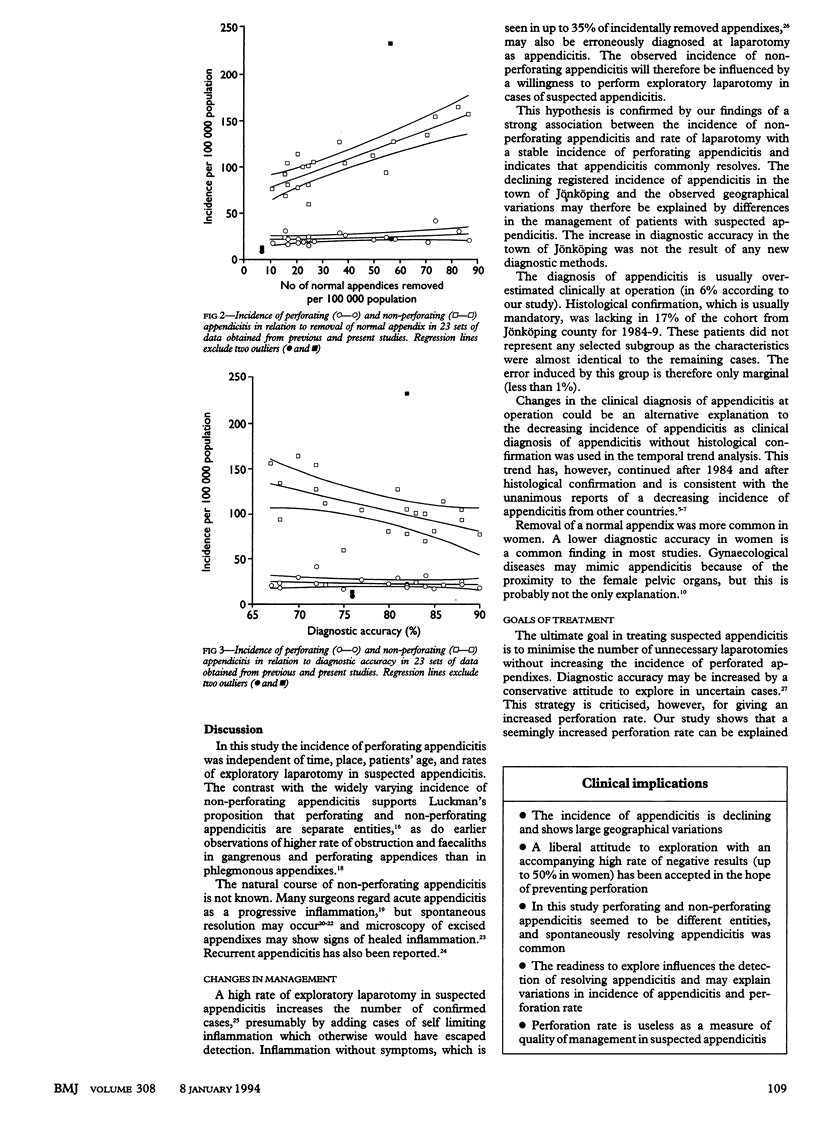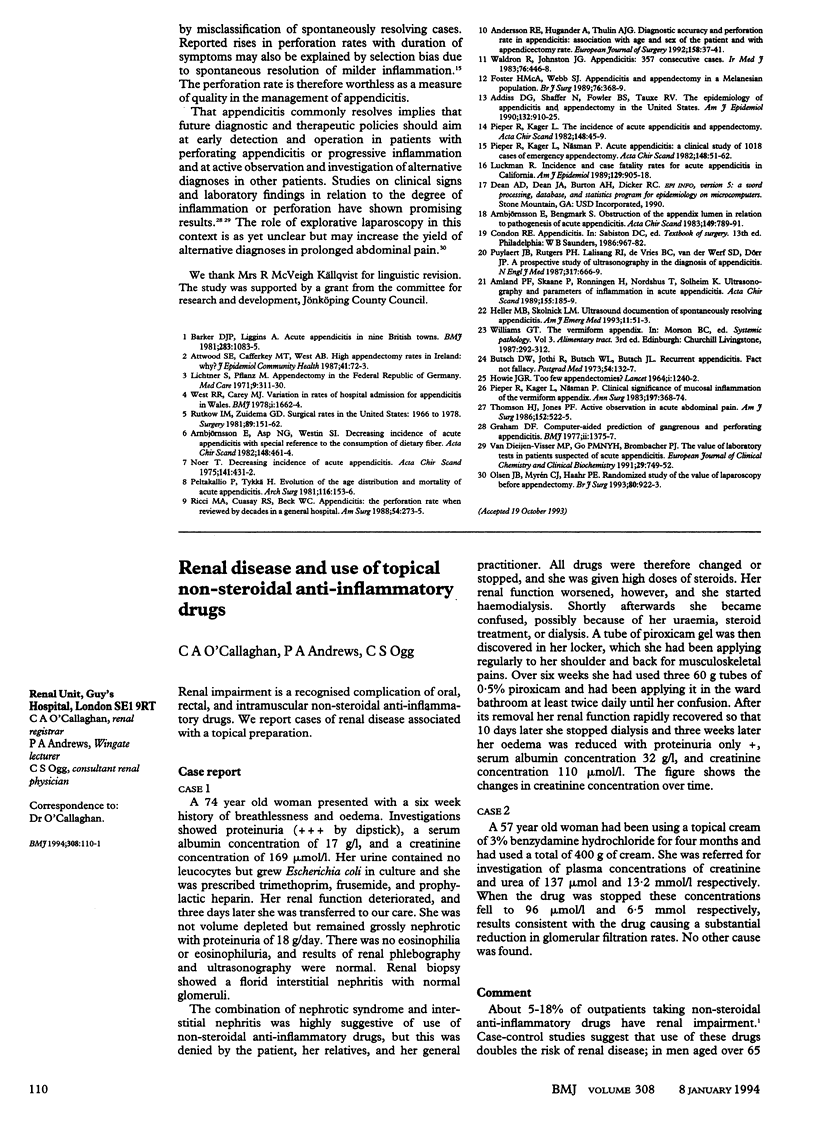Abstract
OBJECTIVE--To clarify poorly understood epidemiological features of appendicitis. DESIGN--Retrospective study of consecutive cases from a defined population and analysis of data from published studies. SETTING--County of Jönköping, Sweden. 3029 patients who underwent operation in 1984-9 and 4717 patients from the county town who underwent operation in 1970-89, all for suspected appendicitis, plus 48,426 cases from six reported studies. MAIN OUTCOME MEASURES--Incidences specific for age and sex and temporal trends of perforating and non-perforating appendicitis and removal of a normal appendix. Associations between diagnostic accuracy, rate of perforation, and incidences of removal of a normal appendix and of perforating and non-perforating appendicitis. RESULTS--The incidence of appendicitis was 116/100,000 inhabitants. Appendicitis was more common in male patients. The incidence of perforating appendicitis was independent of age, stable over time, and uninfluenced by the rate of laparotomy, whereas the incidence of non-perforating appendicitis was age dependent, decreasing over time, and related to the diagnostic accuracy and rate of removal of a normal appendix. CONCLUSIONS--Perforating and non-perforating appendicitis seem to be separate entities, and appendicitis that resolves spontaneously is common. This may have important implications for managing suspected appendicitis.
Full text
PDF



Selected References
These references are in PubMed. This may not be the complete list of references from this article.
- Addiss D. G., Shaffer N., Fowler B. S., Tauxe R. V. The epidemiology of appendicitis and appendectomy in the United States. Am J Epidemiol. 1990 Nov;132(5):910–925. doi: 10.1093/oxfordjournals.aje.a115734. [DOI] [PubMed] [Google Scholar]
- Amland P. F., Skaane P., Rønningen H., Nordshus T., Solheim K. Ultrasonography and parameters of inflammation in acute appendicitis. A comparison with clinical findings. Acta Chir Scand. 1989 Mar;155(3):185–189. [PubMed] [Google Scholar]
- Andersson R. E., Hugander A., Thulin A. J. Diagnostic accuracy and perforation rate in appendicitis: association with age and sex of the patient and with appendicectomy rate. Eur J Surg. 1992 Jan;158(1):37–41. [PubMed] [Google Scholar]
- Arnbjörnsson E., Asp N. G., Westin S. I. Decreasing incidence of acute appendicitis, with special reference to the consumption of dietary fiber. Acta Chir Scand. 1982;148(5):461–464. [PubMed] [Google Scholar]
- Butsch D. W., Jothi R., Butsch W. L., Butsch J. L. Recurrent appendicitis: fact not fallacy. Postgrad Med. 1973 Oct;54(4):132–137. doi: 10.1080/00325481.1973.11713586. [DOI] [PubMed] [Google Scholar]
- Foster H. M., Webb S. J. Appendicitis and appendicectomy in a Melanesian population. Br J Surg. 1989 Apr;76(4):368–369. doi: 10.1002/bjs.1800760417. [DOI] [PubMed] [Google Scholar]
- Graham D. F. Computer-aided prediction of gangrenous and perforating appendicitis. Br Med J. 1977 Nov 26;2(6099):1375–1377. doi: 10.1136/bmj.2.6099.1375. [DOI] [PMC free article] [PubMed] [Google Scholar]
- HOWIE J. G. TOO FEW APPENDICECTOMIES? Lancet. 1964 Jun 6;1(7345):1240–1242. doi: 10.1016/s0140-6736(64)91867-7. [DOI] [PubMed] [Google Scholar]
- Lichtner S., Pflanz M. Appendectomy in the Federal Republic of Germany: epidemiology and medical care patterns. Med Care. 1971 Jul-Aug;9(4):311–330. doi: 10.1097/00005650-197107000-00003. [DOI] [PubMed] [Google Scholar]
- Noer T. Decreasing incidence of acute appendicitis. Acta Chir Scand. 1975;141(5):431–432. [PubMed] [Google Scholar]
- Peltokallio P., Tykkä H. Evolution of the age distribution and mortality of acute appendicitis. Arch Surg. 1981 Feb;116(2):153–156. doi: 10.1001/archsurg.1981.01380140015003. [DOI] [PubMed] [Google Scholar]
- Pieper R., Kager L., Näsman P. Acute appendicitis: a clinical study of 1018 cases of emergency appendectomy. Acta Chir Scand. 1982;148(1):51–62. [PubMed] [Google Scholar]
- Pieper R., Kager L., Näsman P. Clinical significance of mucosal inflammation of the vermiform appendix. Ann Surg. 1983 Mar;197(3):368–374. doi: 10.1097/00000658-198303000-00019. [DOI] [PMC free article] [PubMed] [Google Scholar]
- Pieper R., Kager L. The incidence of acute appendicitis and appendectomy. An epidemiological study of 971 cases. Acta Chir Scand. 1982;148(1):45–49. [PubMed] [Google Scholar]
- Puylaert J. B., Rutgers P. H., Lalisang R. I., de Vries B. C., van der Werf S. D., Dörr J. P., Blok R. A. A prospective study of ultrasonography in the diagnosis of appendicitis. N Engl J Med. 1987 Sep 10;317(11):666–669. doi: 10.1056/NEJM198709103171103. [DOI] [PubMed] [Google Scholar]
- Ricci M. A., Cuasay R. S., Beck W. C. Appendicitis: the perforation rate when reviewed by decades in a general hospital. Am Surg. 1988 May;54(5):273–275. [PubMed] [Google Scholar]
- Rutkow I. M., Zuidema G. D. Surgical rates in the United States: 1966 to 1978. Surgery. 1981 Feb;89(2):151–162. [PubMed] [Google Scholar]
- Thomson H. J., Jones P. F. Active observation in acute abdominal pain. Am J Surg. 1986 Nov;152(5):522–525. doi: 10.1016/0002-9610(86)90220-5. [DOI] [PubMed] [Google Scholar]
- Waldron R., Johnston J. G. Appendicitis: 357 consecutive cases. Ir Med J. 1983 Nov;76(11):446–448. [PubMed] [Google Scholar]
- West R. R., Carey M. J. Variation in rates of hospital admission for appendicitis in Wales. Br Med J. 1978 Jun 24;1(6128):1662–1664. doi: 10.1136/bmj.1.6128.1662. [DOI] [PMC free article] [PubMed] [Google Scholar]
- van Dieijen-Visser M. P., Go P. M., Brombacher P. J. The value of laboratory tests in patients suspected of acute appendicitis. Eur J Clin Chem Clin Biochem. 1991 Nov;29(11):749–752. doi: 10.1515/cclm.1991.29.11.749. [DOI] [PubMed] [Google Scholar]


